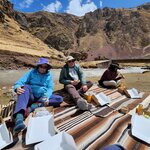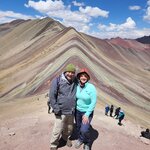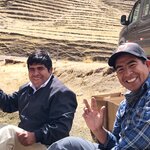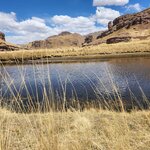
Inca Trail to Machu Picchu

Note: The 5-day group departures listed above include the Inca Trail and Machu Picchu portions of the itinerary below (days 3-7). Our specialists can help you plan the rest of the trip around your chosen departure date. Let one of our trusted local operators help you plan your trip.
Highlights
- Embark from Ollantaytambo, one of South America’s oldest villages
- Crossover Dead Woman’s Pass (4212m) for breathtaking views of Pumahuanca
- Camp at Phuyupatamarca, “‘the place above the clouds”
- Descend the Wiñay Wayna terraces and through the Intipunku gateway
Overview
Originally a pilgrimage route meant only for Inca nobles, thousands of trekkers each year now follow this ancient footpath to Machu Picchu. It’s no surprise why this path was chosen: the mountaintop views are stunning, and you'll pass through numerous ruins along the way.
Throughout the trek, you'll pass through cloud forests and below snowy peaks and discover the world of the Incas. Following a centuries-old sacred trail, you will visit a variety of historic sites, culminating at Machu Picchu, the most famous and grand of them all.
Note: If you're short on time, be sure to check out the Short Inca Trail trek which follows the last day of the Inca Trail.
Brief itinerary
| Day | Destination | Overnight |
|---|---|---|
| Day 1 | Arrival in Lima | Lima |
| Day 2 | Arrival in Cusco & Sacred Valley Tour: Cusco - Chinchero - Ollantaytambo | Ollantaytambo |
| Day 3 | Inca Trail Day 1/4: Your Inca Trail Journey Begins | Llactapata |
| Day 4 | Inca Trail Day 2/4: Into the Cloud Forest | Llulluchapampa |
| Day 5 | Inca Trail Day 3/4: Mountains and Valleys | Phuyupatamarca |
| Day 6 | Inca Trail Day 4/4: Machu Picchu | Aguas Calientes |
| Day 7 | Explore Machu Picchu and return to Cusco | Cusco |
| Day 8 | Departing Cusco |
Detailed Itinerary
Day 1: Arrival in Lima

¡Bienvenidos! Welcome to Lima, Peru's largest city and central metropolitan hub, and home to one-third of the country's population. Located at the site of a pre-Columbian indigenous Ychsma settlement, which was conquered by the Inca empire in the 15th century and later by the Spanish conquistadores, Lima has a fascinating history and a diverse mix of cultures. Amerindian, European, Afro-Peruvian, and Asian—especially Chinese and Japanese—influences make Lima a dynamic and exciting city to explore.
Lima's breezy location on the Pacific Ocean and mild desert climate make it the perfect city for exploring on foot. Head downtown to mingle with locals, stretch your legs, and grab a bite to eat in one of the many award-winning restaurants.
Suggested activities include:
-
Explore the historic center of Lima, a UNESCO World Heritage Site packed with fascinating Spanish architecture. Start with a scenic tour of the colonial downtown, which emanates from the main square. Stroll over to the 16th-century Cathedral, which took 80 years to construct and was built in the grandiose style of the Spanish Empire.
-
Visit the Casa Aliaga, a colonial mansion granted by chief conquistador Francisco Pizarro to Jerónimo de Aliaga, one of his captains, in 1535. This is the only house from that era that still belongs to the same family.
-
Stroll around the Pueblo Libre district to the privately owned Larco Museum of pre-Columbian art, housed in a beautifully restored viceregal mansion built over a 7th-century pre-Columbian pyramid. The museum boasts a vast pre-Colonial collection of gold and silver artifacts.
- In the evening, head to the eclectic "Love Park" in the upscale coastal district of Miraflores, where you can admire a huge kissing statue and beautiful mosaic walls. The park is built on the cliffs of Chorrillos and is a perfect place to enjoy a spectacular sunset over the Pacific.
- Enjoy a nightcap at an open-air cafe or restaurant in the diverse Miraflores neighborhood.
Day 2: Arrival in Cusco & Sacred Valley Tour: Cusco - Chinchero - Ollantaytambo

This morning, you will be transferred to the Lima airport to catch your flight from Lima to Cusco. Upon arrival in Cusco, you will be greeted and begin your Sacred Valley Tour.
First, head to the village of Chinchero, believed by the Inca to be the birthplace of the rainbow. You will see extensive Inca terraces and several small colonial-era churches. Next, take some time to explore Chinchero's famous textile markets and browse the selection of vibrant textiles for the perfect handmade gift.
Continue to Moray, a series of incredible stone amphitheaters built by the Inca. Considered one of the world's most innovative and architecturally advanced cultures, the Inca likely used these stone complexes for experimental agriculture in micro-climates.
From Moray walk (or take a bus) to the Salineras—the Moray Salt Flats—an intricate network of stone pools developed by the Inca to harvest salt through evaporation. These salt flats are still in use today and are carefully maintained by a close community with regulations and rules that date back to the time of the Inca.
Spend the night in the small historic town of Ollantaytambo, high in the Sacred Valley. Explore the surrounding stone fortresses, archeological ruins, and cobblestone streets of the town, which remain remarkably intact similar to their original appearances after construction by the Inca.
Day 3: Your Inca Trail Journey Begins

Start your trek from the charming town of Ollantaytambo, famous for its Incan fortress and temple ruins. Explore the cobblestone streets and observe life in the Andes. After lunch, drive to the trailhead at Piscacucho and meet the crew that will be accompanying you on the trail.
The hike starts out by following a trail along the winding Urubamba river. With porters carrying your belongings, you will be able to enjoy the natural beauty with less stress. After a long day of trekking, you will reach Llactapata (2788m), the ruins of a grand administrative and astronomical complex. Set up camp with help from your crew, enjoy a freshly-cooked meal, and relax and enjoy the accomplishment of your first day.
Day 4: Into the Cloud Forest

After breakfast, prepare to climb up the edge of Cusichaca Valley to Huayllabamba, a small village that will be the last human settlement on the Inca Trail. Afterward, you will descend into true wilderness.
Hike a steeper Inca trail that brings you into the beautiful cloud forests, where flora and fauna flourish. You may even spot hummingbirds fluttering among the tropical trees. The trail leads to Llulluchapampa (3680m), a patch of grassland frequented by Andean deer with an amazing view. Here, you will end the day and prepare your camp.
Day 5: Mountains and Valleys

Today is the most rigorous day of the trek, but the challenge is worth it. Climb the trail’s highest and most demanding pass, the Warmiwañusca, or “Dead Woman’s Pass” (4212m). After that, everything gets smoother as you walk downhill the Pacasmayo valley. You will hike through a second pass past Runkuracay towards Sayacmarca, where you will be rewarded with a breathtaking view of Pumahuanca Mountain.
After the mysterious junction point, your trek continues just a bit longer. Phuyupatamarca (3650m), “‘the place above the clouds” will be your final destination for today. The site features one of the most intact Inca ruins and overlooks snow-capped, sacred Mt. Salkantay (6,200m). Surrounded by clouds, miles above the rest of the world, you will spend your night.
Day 6: Arrive at Machu Picchu

If the clouds clear up, you will wake up to the rising sun illuminating the Salkantay and Veronica mountains. Then, bid farewell to your porters and carry on towards Machu Picchu.
Continue down a set of Inca stone steps past more swaths of misty cloud forests. Soon, you will pass the Wiñay Wayna, a range of terraces with patches of orchids and swallows flying overhead. Finally, trek beyond the Gateway of the Sun, Inti Punku, and the sight of Machu Picchu will await you. Soak in the view and the evening glow before riding the bus 20 minutes down to Machu Picchu Pueblo, where you can shower and retreat to a comfortable hotel room.
Day 7: Explore Machu Picchu and return to Cusco

Wake up early, well rested, and ride the bus up for your second, complete chance to see Machu Picchu. A UNESCO World Heritage Site and one of the Seven New Wonders of the World, the hilltop citadel deserved every bit of its fame. Explore every last stone of the complex without the hustle and bustle of other tourist crowds.
The stunning walls, temples, and palaces of Machu Picchu take time to fully appreciate. Afterward, you can also trek an extra hour to visit the Sun Gate or opt for a shorter walk to a cliffside bridge. Then, your adventure comes to an end. Ride the scenic Vistadome train in comfort back to Cusco, as you cherish the memories you’ve made over the past few days.
Day 8: Departing Cusco

Today is your last day in Peru! You will be met at your hotel for a transfer to the Cusco Airport, where you will transfer to your international departure. ¡Buen viaje!
When to hike the Inca Trail
Late spring and early autumn offer the best balance of dry weather and fewer crowds. The rainy season lasts from November to April, in which trail conditions are less ideal. Common vacation times (December and most of the summer) see the most crowds, although much of it will be avoided with this itinerary. The trail is closed for maintenance in February, the peak of the rainy season. Be sure to obtain your mandatory permit for the Inca Trail in time and book months in advance. For more information, read more about the best time to visit Peru.
Ready to start planning your trek?
Get connected to a knowledgeable trekking specialist in Peru who can help you start organizing your trek. Click here to start planning.
Note: The 5-day group departures listed below include the Inca Trail and Machu Picchu portions of the itinerary above (days 3-7). Our specialists can help you plan the rest of the trip around your chosen departure date.






